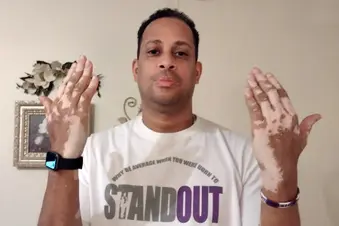
By Mark Braxton, as told to Kendall Morgan
In 1996, I discovered a small white spot on my thumb. It itched. I thought it was a scab or something. I didn’t think too much about it. Then, I started noticing other small white spots. They were spreading.
The first dermatologist I went to looked at me and walked right back out of the room. He came back in with a pamphlet and said, “This is what you have: vitiligo.” At that time, there wasn’t a lot of information. The doctor gave me a topical cream for it. I tried it for 6 months. It didn’t seem to me it was helping, so I stopped. I felt deflated.
Thankfully, when I went to another dermatologist, it was a different experience. He shook my hand. He knew immediately I wanted to know about the spots. He explained that I have vitiligo, which is a skin condition. It’s not contagious, which is important for people to know. There’s no cure or way to stop the loss of skin color. He told me that it could spread or maybe some of the pigment would come back. Then he asked me a question I didn’t expect, “How is your self-esteem?”
At that time, I felt good. It was just a couple of small spots. Over the years, as it started to spread and I could see changes, I started to feel more insecure. I have it around my mouth now and all over my body in spots. I stopped wearing shorts. I stopped going to the beach and the pool. I would avoid social settings where people could look at me. It was insecurity and sometimes slight depression and anxiety.
The mental aspect is probably the biggest challenge I’ve dealt with. Vitiligo changed my outlook on myself. I didn’t see myself how others saw me. I struggled socially with friendships and relationships. One of the worst things I’ve found that people can say is that it doesn’t bother them. I understand you may say it doesn’t bother you, but until you walk in my shoes, you don’t understand. You don’t have to look in the mirror watching your body or skin change over time. There’s this fear of the unknown.
I haven’t sought treatment, although it has been offered. The creams I tried at first didn’t seem to help. Light therapy is an option, but it’s time consuming and I didn’t want to risk getting burned. I thought I could do this all on my own. In 2019, I realized I’d been failing. Something a child said helped me start to shift my perspective. I was working at a camp and this little girl told me that I was a butterfly. She identified my spots as a butterfly, as something beautiful.
I decided it was time to open up. I joined the North Carolina Vitiligo Support Community after avoiding it for years. It was the best decision I ever made. For so long, my vitiligo was something that I never talked about. My family and friends didn’t know how I felt about it. I started sharing my journey with other people, and it helped so much.
I’m now one of two leaders for the North Carolina Vitiligo Support Community in Raleigh,. I’m also on the board of directors for VITFriends, which is a national organization that nurtures peer-to-peer relationships in the vitiligo community. I host a podcast called Living Life and Love, where others with vitiligo can share their journey. I found that sharing my own journey with such a large audience released me from a personal prison I’d been living in for too long.
Having this skin condition has opened my eyes in many ways. I’ve come to a place of acceptance. I’ve learned how to live with vitiligo and love myself. Some days are still hard if someone whispers or stares too hard. Kids are often curious and that’s OK. I try to educate people about what vitiligo is.
When it comes down to it, my skin looks different, but I still have interests, hobbies, and talents. I enjoy writing poetry and short stories. I like to paint and draw and be creative. I’m a big fan of science fiction and superheroes. We all have much more in common than we don’t. I’ve gone from being insecure to being secure in myself. I often say that it’s a process for all of us in the vitiligo community. Every journey is different. Everyone has a story to tell.
Show Sources
Photo Credit: Mark Braxton
SOURCES:
Mark Braxton, Raleigh, NC.
Mayo Clinic: “Vitiligo.”